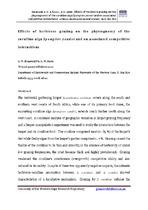| dc.contributor.author | Maneveldt, Gavin | |
| dc.contributor.author | Keats, Derek | |
| dc.date.accessioned | 2013-09-02T12:33:05Z | |
| dc.date.available | 2013-09-02T12:33:05Z | |
| dc.date.issued | 2008 | |
| dc.identifier.citation | Maneveldt, G.W. & Keats , D.W. (2008). Effects of herbivore grazing on the physiognomy of the coralline alga Spongites yendoi and on associated competitive interactions. African Journal of Marine Science, 30(3): 581‐593 | en_US |
| dc.identifier.issn | 1814-232X | |
| dc.identifier.uri | http://hdl.handle.net/10566/707 | |
| dc.description.abstract | The territorial gardening limpet Scutellastra cochlear occurs along the south and southern west coasts of South Africa, while one of its primary food items, the encrusting coralline alga Spongites yendoi, extends much further north along the west coast. A combined analysis of geographic variation in limpet grazing frequency and a limpet-manipulation experiment was used to study the interaction between the limpet and its coralline food. The coralline comprised most (c. 85 %) of the limpet’s diet while fleshy algae from the limpet’s garden comprised c. 7 %. Grazing caused the thallus of the coralline to be thin and smooth; in the absence of herbivory, or under low grazing frequencies, the crust became thick and highly protuberant. Grazing weakened the coralline’s interference (overgrowth) competitive ability and also reduced its fecundity. In spite of these two apparently negative impacts, the intimate herbivore-coralline association between S. cochlear and S. yendoi showed characteristics of a facultative mutualism. Grazing by S. cochlear reduces the coralline’s thallus thickness and consequently increased its lateral margin extension rate. Thinner forms of the coralline grew 5X faster than thicker forms. An increased
lateral growth results in the thinner form of the coralline being very abundant on south and southern west coasts, occupying as much as 79 % of the substratum in the lower eulittoral zone. Thinner forms of S. yendoi were also less burrowed by boring organisms and more strongly attached than thicker forms of the coralline. Grazing by S. cochlear has thus conferred the advantages of faster lateral growth (i.e. success at exploitation competition) and stronger attachment. The coralline and fleshy algae from the limpet’s garden were equally high in organic content on a volume basis. This suggests that the crude food value per bite in the coralline and fleshy algae is comparable. This study has shown that incompletely overlapping distributions between strongly interacting species along a broad geographical gradient is not just a significant feature of the ecology of terrestrial, but also of marine ecosystems. | en_US |
| dc.language.iso | en | en_US |
| dc.publisher | National Inquiry Services Centre (NISC) and Taylor & Francis | en_US |
| dc.rights | Copyright National Inquiry Services Centre (NISC) and Taylor & Francis. This file may be freely used provided that the source is acknowledged. No commercial distribution of this text is permitted. | |
| dc.source.uri | http://dx.doi.org/10.2989/AJMS.2008.30.3.11.645 | |
| dc.subject | Herbivore-coralline association | en_US |
| dc.subject | Herbivory | en_US |
| dc.subject | Coralline | en_US |
| dc.subject | Limpet | en_US |
| dc.subject | Growth | en_US |
| dc.subject | Competition | en_US |
| dc.subject | Fecundity | en_US |
| dc.subject | Morphology | en_US |
| dc.subject | Scutellastra cochlear | en_US |
| dc.subject | South Africa | en_US |
| dc.subject | Spongites yendoi | en_US |
| dc.title | Effects of herbivore grazing on the physiognomy of the coralline alga Spongites yendoi and on associated competitive interactions | en_US |
| dc.type | Article | en_US |
| dc.privacy.showsubmitter | false | |
| dc.status.ispeerreviewed | true | |
| dc.description.accreditation | Web of Science | en_US |

